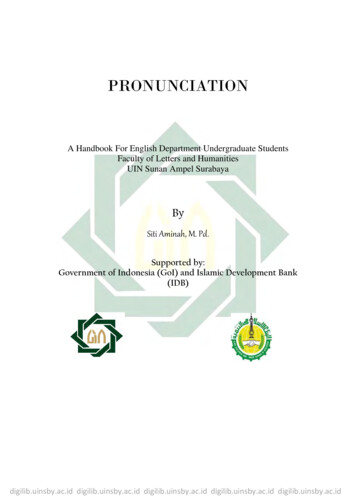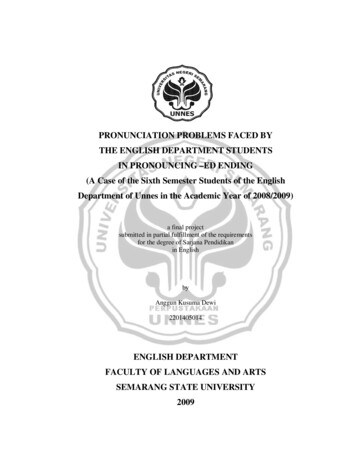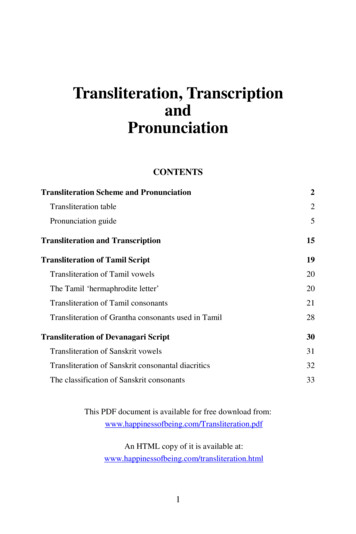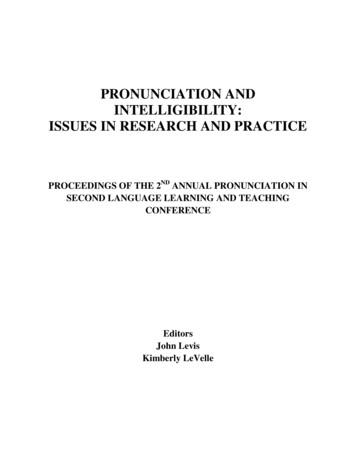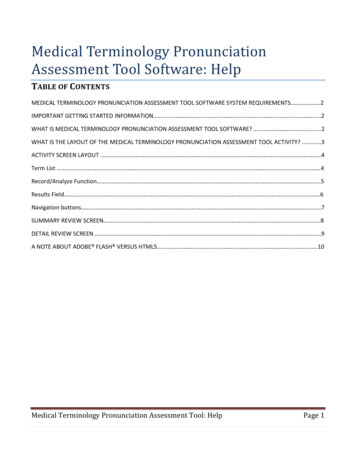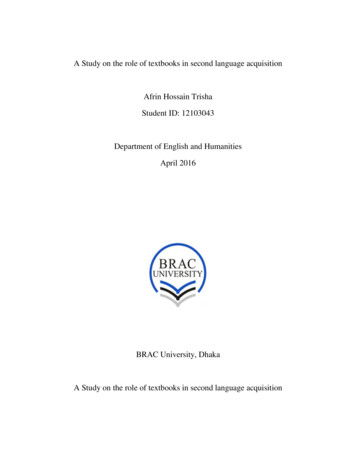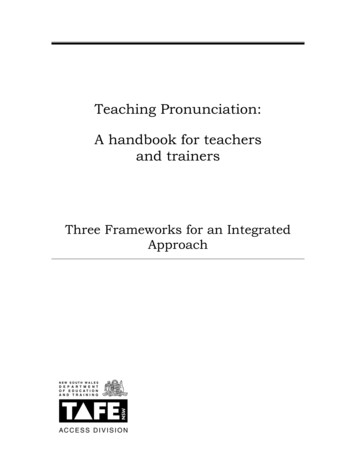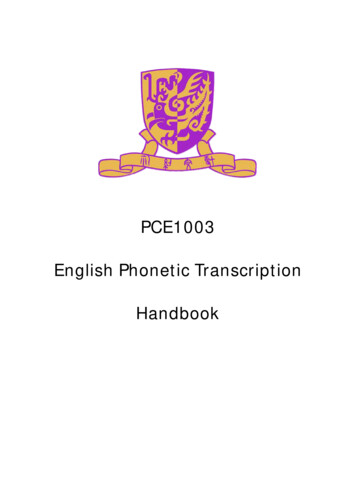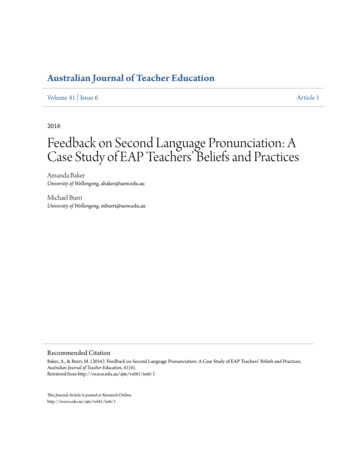
Transcription
Australian Journal of Teacher EducationVolume 41 Issue 6Article 12016Feedback on Second Language Pronunciation: ACase Study of EAP Teachers’ Beliefs and PracticesAmanda BakerUniversity of Wollongong, abaker@uow.edu.auMichael BurriUniversity of Wollongong, mburri@uow.edu.auRecommended CitationBaker, A., & Burri, M. (2016). Feedback on Second Language Pronunciation: A Case Study of EAP Teachers’ Beliefs and Practices.Australian Journal of Teacher Education, 41(6).Retrieved from http://ro.ecu.edu.au/ajte/vol41/iss6/1This Journal Article is posted at Research Online.http://ro.ecu.edu.au/ajte/vol41/iss6/1
Australian Journal of Teacher EducationFeedback on Second Language Pronunciation:A Case Study of EAP Teachers’ Beliefs and PracticesAmanda BakerMichael BurriUniversity of WollongongAbstract: In the modern English language classroom, teachers are oftenfaced with the challenging task of supporting students to achievecomprehensible pronunciation, but many teachers limit or neglect givingstudents feedback on their pronunciation for a variety of reasons. Thispaper examines the case of five experienced English for AcademicPurposes (EAP) instructors who strive to provide feedback on specificfeatures of pronunciation that negatively affect students’comprehensibility. Results derived from semi-structured interviews,classroom observations and stimulated recall interviews reveal that theteachers use similar approaches to select and provide feedback onproblematic features of pronunciation. Naturally, these approachessometimes differed to better suit their particular classroom needs. Thepaper concludes with a discussion of several practical solutions forproviding corrective feedback and implications for teacher educationprograms.KeywordsSecond language teacher education, pronunciation, feedback, teacher cognitionIntroductionOne of the challenges faced by English for Academic Purposes (EAP) teachers today isdetermining not just how to provide feedback on learner pronunciation, but when to actually doso. As pronunciation is an essential element of communicative competence (Goh & Burns,2012), but a skill frequently given insufficient attention in many EAP classrooms (Derwing &Rossiter, 2002; Foote, Trofimovich, Collins, & Urzúa, 2013), there is a clear need for teachers toenhance their knowledge of not only English phonology, but how to effectively teach and givelearners feedback on it. This paper aims to investigate these questions by examining the beliefsand practices of experienced EAP instructors who attempt to provide English as a SecondLanguage (ESL) learners with feedback on their pronunciation.For many teachers, faced with such uncertainty, plus a belief that teaching and givingfeedback on learner pronunciation is too time-consuming a task (Khaghainejad, 2015; Warren,Elgort, & Crabbe, 2009), teachers may choose to limit classroom time spent on pronunciationinstruction or neglect it altogether. In the EAP classroom, teachers struggle with significant timeVol 41, 6, June 20161
Australian Journal of Teacher Educationlimitations as they are often required to meet the demands of a strict curriculum focusing onmultiple language skills, of which pronunciation is typically viewed as only one smallcomponent. Failing to give sufficient attention to pronunciation is problematic, however,particularly in light of research demonstrating the positive impact that pronunciation instructionmay have on student learning (Lee, Jang, & Plonsky, 2015; Saito & Lyster, 2012) and howimportant clear pronunciation is to achieving successful communication (Celce-Murcia, Brinton,Goodwin, & Griner, 2010). Given this classroom reality, how can EAP teachers successfullymeet the needs of their students?The answer to this question lies, at least in part, in the notion of comprehensibility, whichis considered the main foci of pronunciation instruction (Munro & Derwing, 1995, 2015). Thisconcept of comprehensibility is generally defined as the listener’s perception of the degree towhich second language (L2) speech is difficult to understand (Derwing, Munro, & Wiebe, 1997,1998). With comprehensible pronunciation serving as the target for achieving successfulcommunication, traditional concerns about the potentially negative effects of accentedness oneffective communication have gradually lessened. Research has demonstrated that stronglyaccented speech does not necessarily interfere with comprehensibility (Munro & Derwing,1995). Thus, the goal of classroom instruction is to enhance the spoken language of speakerswhose pronunciation difficulties interfere with their comprehensibility.Yet concerns over accented speech can pose a challenge for teachers from a differentperspective. Increasingly, over the past few decades, advocates of international varieties ofEnglish have argued for the acceptance of diverse English dialects (Jenkins, 2007; Murphy,2014a). But, in the classroom, it can be challenging for teachers to focus on comprehensiblepronunciation without feeling that they may be failing to demonstrate appropriate levels ofrespect for the learner’s particular variety of English. Even with guides on how to teachpronunciation (e.g., Celce-Murcia et al, 2010; Cox, 2012), many teachers may have concernsabout what they can or should do when giving feedback on learner pronunciation.Furthermore, many teachers may lack the knowledge of how to adequately assesspronunciation or even have access to tools to formally assess learner pronunciation (Macdonald,2002). Without sufficient training in how to assess learner speech and identify features ofpronunciation that cause communication breakdowns, teachers may lack sufficient knowledge onhow to improve their pronunciation. Overall, any one or more of the concerns outlined abovemay lead to the neglect of pronunciation instruction in the classroom. What we need is to look atwhat EAP teachers believe and actually do, specifically those who do address pronunciationissues in their classrooms.Goals of the Language LearnersAchieving native-like pronunciation in English has been a long-term goal of manylanguage learners. Numerous studies have demonstrated that English language learners haveidealized some form of “standard” English, and have nurtured the desire to develop a native-likevariety (Derwing & Munro, 2003; Kang, 2010; Scales, Wennerstrom, Richard, & Wu, 2006;Timmis, 2002). One of the reasons for these aspirations may be attributed to cases ofemployment discrimination, both in English and non-English speaking countries. The continuedpractices of many businesses and institutions world-wide to hire people with “native-speaker”Vol 41, 6, June 20162
Australian Journal of Teacher Educationvarieties of English has been well-documented over the years (e.g., Borg & Al-Busaidi, 2012;Carlson & McHenry, 2006; Clark & Paran, 2007; Hosoda & Nguyen, 2012).It is generally acknowledged, however, that modifying one’s pronunciation to achievenative-like status is exceedingly difficult for a large majority of adult L2 English speakers(Loewen, 2015; Scovel, 2001). Following the onset of puberty – the “critical” age –, it appearsthat adult learners may experience increasing difficulties with adopting native-like pronunciationin English. Reasons for these observed difficulties may not necessarily result from a critical ageper se, but rather from sociocultural factors that can impede the acquisition of an L2. Perhapsfirst and foremost is the choice of the learner to interact in the L2. Research has demonstrated,for example, that adults who spend more time interacting in and using their L2 are considerablymore likely to acquire target-like pronunciation than those who spend more time interacting withspeakers of their L1, regardless of the country they live in (Flege, Frieda, Walley, & Randazza,1998; Riney & Flege, 1998). Even for adult learners who have been speaking English as asecond language for years, it is possible to change their pronunciation, especially by increasingtheir language awareness and through corrective feedback (Derwing & Munro, 2014).Another significant obstacle is one that directly conflicts with the learners’ claimed desirefor native-like pronunciation: their desire to maintain their sense of personal identity (Gatbonton,Trofimovich, & Magid, 2005). A person’s identity is intricately and rather intimately connectedto their pronunciation. This connection raises concerns that in helping learners to modify theirpronunciation, teachers are simultaneously casting negative judgements on the learner’s identityrather than helping learners to communicate successfully with other English speakers. Derwingand Munro (2009) argueIf someone wishes to retain his or her identity through accent, that is apersonal choice. But denying students help with intelligibility on thebasis of protecting their identity seems not only misguided butpaternalistic. Identity and intelligibility are both obviously important, butwhen it comes to sacrificing intelligibility FOR identity, there is noreason to believe that many learners will make that choice. Surely, if oneis intelligible and comprehensible, one’s expression of identity will comethrough more clearly (p.485).Ultimately, teachers need to support students to achieve a level of English pronunciation that iscomprehensible to listeners from diverse language backgrounds.Limited L2 Pronunciation InstructionAnother important barrier to a learner’s acquisition of a clear L2 pronunciation may beattributed to a lack of instruction in English pronunciation. This neglect may result from theteachers’ level of comfort in teaching pronunciation or a deficiency in L2 teacher education asdiscussed below. In the case of “non-native” speakers of English, one of the main contributingfactors can be a lack of confidence in their own L2 variety of English (Jenkins, 2007). Yet, thislack of confidence in teaching pronunciation is not limited to only non-native speakers, but tonative-speakers as well, but for different reasons. For the native speakers, their limitedconfidence is frequently attributed to insufficient training in pronunciation pedagogy (Baker,2011a, 2011b; Fraser, 2001; Macdonald, 2002; Murphy, 2014b). Even though they may haveconfidence in speaking their particular dialect of English, without this training in pronunciationVol 41, 6, June 20163
Australian Journal of Teacher Educationpedagogy, they may have a limited understanding of the mechanics involved in the production ofsounds, stress, rhythm and intonation and how to describe these processes to students. Inaddition, for all teachers in EAP settings, there is the added complication of teaching ESLstudents from diverse linguistic backgrounds, as it can be difficult to identify their specificpronunciation-oriented needs (Schaetzel & Low, 2009) and to determine how to best prioritizethese needs in the classroom. More specialized training in pronunciation pedagogy in teachereducation is clearly needed to support teachers to address these challenges and give greaterattention to pronunciation in the classrooms.The Powerful Influence of Teachers’ Cognitions on Classroom PracticeThe successful implementation of any particular curricular content, teaching approach ortechnique is largely dependent on the strength of teachers’ cognitions in relation to itsimplementation. Teacher cognition, defined as teachers’ beliefs, knowledge and perceptions inconnection to what they actually do in the classroom (Borg, 2003), can play an integral role inthe degree to which pronunciation may be taught or addressed in the classroom. Investigatingteachers’ cognitions is an essential component of any research into classroom practices.Teachers’ beliefs, attitudes, thoughts and opinions (their cognitions) ultimately influence whatthey do in the classroom and, conversely, what teachers learn from their experiences in theclassroom further informs their perceptions, knowledge and practice. Thus, understandingteachers’ cognitions provides insights into the how and why behind choices teachers make. Theneglect of pronunciation instruction, as discussed earlier, is a classic example of how limitedknowledge of pronunciation pedagogy may have a negative impact on what teachers choose tofocus on (or not focus on) in the classroom.However, little empirical research has emerged on the beliefs and practices of L2 teachersin the realm of pronunciation pedagogy (Baker, 2014), but especially as relevant to providingfeedback on learner pronunciation, which is the focus of the current paper. This lack of researchis problematic given that many teachers struggle to determine how to give pronunciation-relatedfeedback to learners. These teachers would benefit from gaining insights into the beliefs andpractices of experienced teachers who have a certain degree of success in feedback-relatedpedagogy. Nevertheless, there has been some research, albeit limited, into this area.A study by Mori (2011) of two teachers in Japan (one native and one non-native speakerof English) found that their cognitions in regards to their provision of corrective feedback (CF)were influenced and mediated by their prior learning experiences and by their knowledge ofsociocultural factors, such as awareness of Japanese societal and institutional norms. This studyis useful in that it provides a window into teachers’ cognitions in the area of CF, but the focus onpronunciation specifically is limited; it only mentions that one of the participants used recasts asa way of providing feedback on learning pronunciation.Three studies, however, have recently emerged with a much stronger emphasis onpronunciation pedagogy in relation to teachers’ cognitions with at least some consideration givento feedback. In the context of public schools in Greece, Sifakis and Sougari (2005) found thatprimary school teachers gave considerably more feedback on learner pronunciation thansecondary school EFL teachers, who rarely gave feedback, at least according to their statedbeliefs. One of the shortcomings of Sifakis and Sougari’s research was that observations ofclassroom practices were not included. As previous research has demonstrated, teachers’ statedVol 41, 6, June 20164
Australian Journal of Teacher Educationbeliefs and actual classroom practices may frequently differ (Basturkmen, Loewen, & Ellis,2004; Collie Graden, 1996; Zacharias, 2005); thus, inclusion of observed teaching is important togain a better understanding of the relationship between the two and to determine why thesedivergences may occur. In a study conducted in Turkey (Phipps & Borg, 2007), which involvedboth interview and observation data of teachers in a DELTA (Diploma in English LanguageTeaching to Adults) course, research revealed additional insight into the area of oral errorcorrection. The researchers found that, even though some teachers consider explicit oral errorcorrection to be desirable, due to “a lack of confidence and concerns about learners’ feelings” (p.17), they may be hesitant to correct students in class. Finally, in the case of university levelstudents in an ESL context, research has shown that students seem to prefer to receive feedbackon their pronunciation more frequently than teachers deemed necessary (Cathcart & Olsen,1976); however, this study was conducted more than three decades ago, prior to the inception ofcommunicative language teaching, an approach which underlies the teaching philosophy of manyEnglish language programs today, especially in ESL contexts.Research into Pronunciation-Focused FeedbackAlthough research into teacher cognition and pronunciation feedback is limited, there hasbeen considerable research conducted into the effectiveness of feedback. In Hattie’s (2009)synthesis of over 800 meta-analyses in the area of student achievement, he describes feedback as information provided by an agent (e.g., teacher, peer, book, parent, orone’s own experience) about aspects of one’s performance orunderstanding. For example, a teacher or parent can provide correctiveinformation, a peer can provide an alternative strategy, a book canprovide information to clarify ideas, a parent can provideencouragement, and a learner can look up the answer to evaluate thecorrectness of a response. Feedback is a “consequence” ofperformance” (p. 174).Hattie further argues that feedback is “one of the most powerful influences on learning, occurstoo rarely, and needs to be more fully researched by qualitatively investigating how feedbackworks in the classroom and learning process” (p. 178). This argument provides an excellentspringboard into an examination of what happens in the EAP classroom with a specific look atpronunciation feedback. In ESL circles, the main area of research focuses on what is termed‘corrective feedback’: the form of responses to learner utterances that contain an error. Theresponses can consist of (a) an indication that an error has beencommitted, (b) provision of the correct target language form, or (c)metalinguistic information about the nature of the error, or anycombination of these. (Ellis, Loewen, & Erlam, 2006, p. 340)Research has shown that corrective feedback (CF) on errors facilitates pronunciationimprovement of language learners (Lee et al., 2015). Of the numerous forms of CF strategiesavailable to teachers (e.g., repetition, explicit correction, clarification requests, metalinguisticinformation, elicitation), one of the most dominant and well-researched types of CF typicallyemployed in the ESL classroom are recasts (Ellis & Sheen, 2006). Although classroom-basedresearch into other areas of language such as morpho-syntactic recasts have shown limitedVol 41, 6, June 20165
Australian Journal of Teacher Educationimpact on learners’ development (Al-Surmi, 2012; Lyster & Saito, 2010), research intopronunciation-specific recasts has achieved more promising results. Observational (Mackey,Gass, & McDonough, 2000) and quasi-experimental (Saito & Lyster, 2012a, 2012b) studies havedemonstrated significant impact on learners’ pronunciation development. Recasting appears tobe particularly beneficial when it is used to draw students’ attention to the problematicpronunciation feature, giving students the opportunity to listen to the teacher’s model and thenimmediately practicing the target pronunciation aloud (Saito & Lyster, 2012b). Simply recastingthe target feature without the student practicing the correct form may not result in any noticing ofthe incorrect form (Yoshida, 2010). Perhaps the most optimal form of CF, however, is when CFin used in tandem with form-focused instruction (FFI). Saito and Lyster’s (2012a) research,exploring the pedagogical effectiveness of form-focused instruction in conjunction with CF onthe pronunciation of Japanese learners of English, revealed that the combination of FFI CF hada significant impact on the pronunciation development of Japanese learners of English. Thisapproach could potentially be further enhanced by incorporating cues (e.g., prosodic emphasis,interrogative intonation) that draw the learner’s attention to communication break downs(Loewen & Philp, 2006).As is apparent from the literature review above, feedback is one of the most importantcontributing factors to a learner’s pronunciation development, but teachers’ cognitions and actualclassroom practices remains an area that is insufficiently researched. As teachers’ beliefs,knowledge and attitudes have a strong influence on their classroom decision-making and actions,and thus their use of feedback, this gap in the research merits close attention, especially if wehope to equip teachers who may be reluctant to teach pronunciation or have insufficientpedagogical content knowledge (Shulman, 1987) to successfully give feedback on learners’speech.The Research StudyResearch Questions and AimIn light of the limited classroom research on teachers’ beliefs and actual practices whenteaching pronunciation, including the provision of feedback, the purpose of the study was toexplore the following two questions:1.What do experienced ESL teachers in an EAP context believe about providing feedbackon learner pronunciation?2.How do these teachers provide feedback on students’ pronunciation in the ESLclassroom?Providing answers to these questions will serve to better inform the preparation of teachers in L2teacher education programs. Based on the results of this study, recommendations for L2 teachereducators will be made as to how to support classroom teachers in providing effective, targetedfeedback on learner pronunciation.Context and CurriculumThe research took place in an EAP program in North America. The overall aim of theprogram is to prepare learners to cultivate English language skills needed to succeed in theirVol 41, 6, June 20166
Australian Journal of Teacher Educationfuture tertiary studies. The current study focused on 14-week courses specifically designed todevelop L2 Oral Communication (OC) skills. The program has five levels of English: Level 1(High Beginner); Level 2 (Low Intermediate); Level 3 (Intermediate); Level 4 (HighIntermediate) and Level 5 (Advanced). OC courses from Levels 1-2 focus on ConversationalEnglish skills, and the curriculum is relatively flexible, allowing teachers to choose the types oftasks to use with learners. Levels 3-5 focus on Academic Oral English, and the curriculum isconsiderably more structured, meaning that the teachers follow a content/task-based curriculumthat has been developed by a committee. The courses are taught with either commerciallypublished textbooks (Levels 1-2 & 4) or in-house developed study guides (Level 3). Unlike theEnglish language programs discussed in the literature review, this program has an explicit focuson pronunciation as integrated with the teaching of other academic-oriented OC skills.Pronunciation is mainly targeted with the lower levels, especially in Levels 1-3 and, to a lesserextent, Level 4. Pronunciation is not explicitly taught in Level 5. Features taught in Levels 1-4(as outlined by the teachers who participated in the study) are listed below. Level 1: Syllables, word endings, consonants, vowels, word stress, rhythm, intonation,connected speechLevel 2: Vowels, consonants, syllables, word endings, word stressLevel 3: Syllables, rhythm, vowels, word stressLevel 4: Syllables, word stress, word endingsParticipantsThe five participants were all experienced ESL teachers with at least six years teachingexperience (either based solely in the USA or oversees as well). Each of the participants hadtaught their respective OC courses at least once in a previous semester: Vala (HighIntermediate); Ginger and Abby (Intermediate); Laura (Low Intermediate) and Tanya (HighBeginning). All names are pseudonyms. These five teachers were chosen based on both theireducation qualifications and experience; they all held a Master’s degree in TESOL (or a relatedfield).MethodsOver the course of a semester, the five teachers participated in three types of datacollection procedures: three semi-structured interviews, five classroom observations, and twostimulated recall interviews. The overall purpose of these interviews and observations was togain insight on the everyday teaching of pronunciation in courses dedicated to OC skills in theEAP classroom. The three semi-structured interviews took place at the beginning (70-90 minutesin duration), 3/4 point (30-40 minutes) and end of the semester (30-40 minutes). The interviewsexamined a variety of aspects of the teachers’ professional learning and teaching histories as wellas their current teaching practices and the rationales underlying how and why they teach,focusing specifically on pronunciation-related practices. For the purpose of the current paper,which focuses on feedback, data collected from the first and second interview are most relevantto the present analysis. Part of the first interview focused on the teachers’ typical practices whenteaching English pronunciation, including how they normally assess students’ pronunciation andVol 41, 6, June 20167
Australian Journal of Teacher Educationprovide feedback on their pronunciation. The second interview focused more specifically on theteachers’ beliefs regarding the students’ beliefs in relation to pronunciation instruction. For thepresent analysis, this involved questions that asked teachers to provide details on whether theybelieved the students wanted feedback on their pronunciation. It also examined teachers’perceptions about what form the students might want to receive this feedback as well as in whatway the teachers provided this feedback.The classroom observations and stimulated recall interviews served to complement thisdata. Each teacher was observed five times throughout the semester with Observations 1-3involving consecutively held lessons in the first half of the semester and Observations 4-5involving consecutively held lessons in the second half of the semester. These 50-minute lessonswere video-recorded and all components related to the teaching/learning of pronunciation weretranscribed verbatim. Immediately after each of these two rounds of observations (usually within48 hours), a stimulated recall interview was conducted. Each stimulated recall interview wasapproximately 60 minutes in duration. This interview involved the teachers reviewing preselected pronunciation-related instructional moments in the video footage and commenting onwhat they believed they were thinking at the time of instruction. The teachers also occasionallyprovided additional rationale for why they chose to give feedback on students’ pronunciation at acertain time or in a particular way.Data AnalysisTo analyse the data, a coding system was first developed to classify the teachers’cognitions and practices. This coding system drew on a modified version of Shulman’s (1986,1987) theoretical model of seven categories of teacher knowledge and Baker’s (2014)classification of 25 pronunciation activities (which was adapted from work of Crookes andChaudron, 2001, Brown, 2007, and Celce-Murcia, et al., 2010). Shulman’s model provedbeneficial to identify diverse, but interrelated components of the teachers’ knowledge,particularly their pedagogical content knowledge (e.g., how to teach English pronunciation),subject matter content knowledge (e.g., knowledge of features of pronunciation), knowledge oflearners and knowledge about curriculum. For example, the various techniques that a teachermight use to provide feedback on learner pronunciation would all be broadly classified as theteachers’ pedagogical content knowledge, whereas the teachers beliefs about what the type offeedback they felt their students wanted would be categorized as knowledge of learners. Baker’sclassification of pronunciation techniques then provided a way to further categorize some of thecomplexities of the teachers’ pedagogical content knowledge, focusing on what types oftechniques the teachers used to teach English pronunciation, broadly classifying them in terms ofcontrolled, guided and free activities. For the purposes of this paper, data categorized asChecking activities (a type of Controlled activity involving the teacher examining student speechand providing feedback on their performance) and Review activities (another type of Controlledactivity where the teacher reviews content taught in a previous lesson) were the primary codesanalysed, encompassing both interview and observation data. The data was initially coded by thefirst author and then a second coder analysed 10% of the data. This data included transcripts ofpronunciation-focused episodes from the observational data and transcripts from the semistructured and stimulated recall interviews. An inter-rater agreement level of 95% was achievedand any differences in coding were discussed and a final code was agreed upon. Major themesVol 41, 6, June 20168
Australian Journal of Teacher Educationidentified in the Findings section below are based on the importance given to feedback-relatedissues or practices by the five EAP teachers.FindingsResults of the study highlighted several key themes from the interview and observationdata that demonstrated both the teachers’ beliefs about providing feedback on learnerpronunciation as well how they actually provided this feedback in the EAP classroom.Common Ground: Feedback is Key to Enhancing Learner ComprehensibilityOne of the major themes that surfaced in the five teachers’ descriptions of why theyprovided explicit feedback on their students’ pronunciation and how they assessed learner speechis the issue of comprehensibility. Although this is a common theme in theoretical and anecdotalresearch in modern classroom teaching, it is nonetheless important to highlight because it servesas evidence of what is happening in actual EAP classrooms. All five teachers, but especiallyGinger, Tanya and Laura, stressed that the purpose of their classes was not to produce learnerswho sounded like native speakers, but rather to enable learners to speak comprehensibly. Tanyaexplained that “it is more important to be comprehensible than to get everything correct.” Lauraadded that “students need to be comprehensible, especially [those] in our program who want togo to university and need to make presentations and need to be able to communicate with theirpeers.” Finally, Ginger highlighted that she does not expect learners to produce native speakerlike speech, but rather achieve an “acceptable pronunciation” which she defined as spokenlanguage that was comprehensible to other English speakers. Thus, the teachers believed that thegoal of feedback should be to enhance learner comprehensibility, regardless of their level oflanguage proficiency, helping learners to communicate successfully in academic OC-orientedtasks. With this foundational belief established amongst all five teachers, the more interestingquestion of how they believed comprehensible English can be achieved can
pronunciation (e.g., Celce-Murcia et al, 2010; Cox, 2012), many teachers may have concerns about what they can or should do when giving feedback on learner pronunciation. Furthermore, many teachers may lack the knowledge of how to adequately assess pronunciation or even have access to tools to formally assess learner pronunciation (Macdonald .
